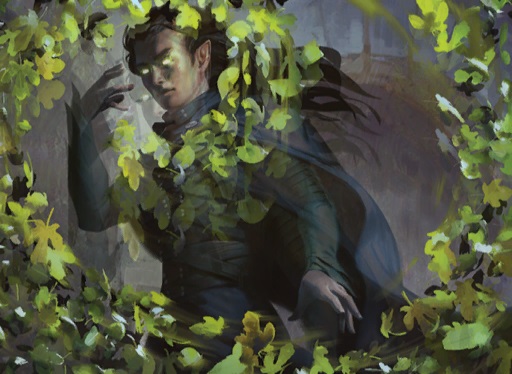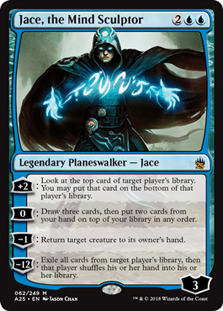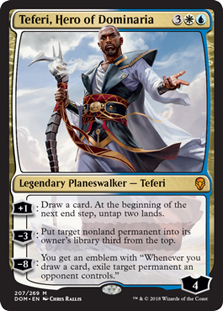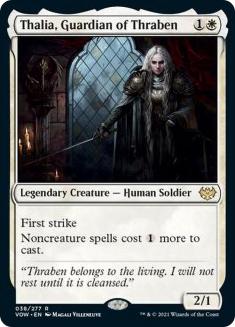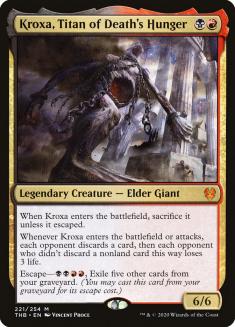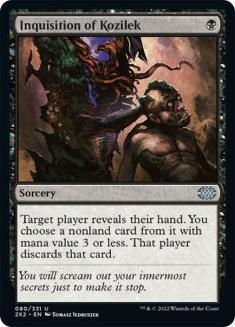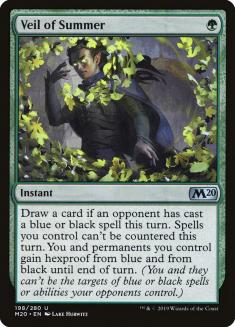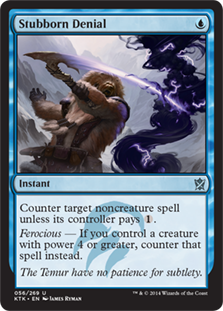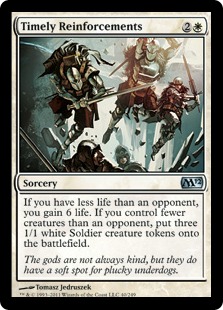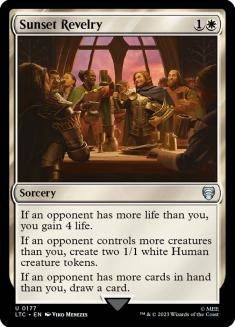Control in Modern, Pioneer, Historic, and Alchemy is at a high point. Experienced pilots can defeat the best decks with relative ease. This is due to the willingness of Studio X at Wizards of the Coast (WotC) to turn back the hands of time by producing powerful interaction that can overcome new-age creatures.
Creatures printed in the last few years have had devastating abilities when they enter or leave the battlefield. When this dynamic transition occurred, WotC was in the process of deleting effective disruption from the traditional control colors. We saw the move from powerful two-mana counterspells to three-mana mediocre options, while also announcing the end of four-mana sweepers. This was a tragedy for lovers of control, hoisting us off the mountaintop of competitive play overnight.
I had hoped for a return to the glory days, and my wish nearly came true. The card designers rolled the dice, possibly listening to certain ravings of a lost control wizard, and began to produce cards to repair the paper-rock-scissors metagame. For a format to be healthy, control, aggro, and midrange must coexist peacefully. These format pieces do not have to be equal in power; however, each must have a competitive shot for success. Combo, big mana, prison, and other fringe options can also make appearances; however, the big three make Magic great.
Viable control cards began flowing into deckbuilders’ coffers, and archetypes long left for dead returned to their former glory. Jace, the Mind Sculptor was unbanned in Modern, better control planeswalkers were printed, Counterspell returned to a relevant format, and white removal was produced that mirrors the power of Sword to Plowshares. These are just some examples of how control survived the dark ages. Although Modern is the prime example, the injection of broken planeswalkers has made control a force in Historic, Alchemy, and Pioneer.
Still, control is beatable in every era and format. These amazing planeswalkers, counterspells, removal, and win conditions have weak points in every format. These flaws can be exploited by bad matchups, a specific effect, or even a single card in some cases. I tend to keep these terrifying strategies to myself, and in many cases I employ them to defeat the mirror.
In a team Pro Tour where I lost very few matches, I was paired in the Esper Control mirror against Shahar Shenhar and Oliver Tiu. Both players were light-years ahead of me in preparation and ability, especially at the time. I dispatched each easily, summoning Chromium, the Mutable, a card that was simply unbeatable in the matchup. This was an example of a single card with deadly effects; alone, it was enough to take down two outstanding professional players in a normally skill-intensive matchup. It won’t always be that easy to defeat control, but some general tips can help you take down the control beast.
Threats
In the Esper Control mirror at that Team Pro Tour, it came down to a legendary creature that defied interaction. Sweepers were weak and did not make it to the sideboarded games, so bringing in Chromium was a no-brainer. Each time such a win condition exists, those who use its services often do well in tournaments.
This rule is not exclusive to the control mirror. Midrange or big mana decks that can go long end the match on the spot by producing such a threat. In older formats I have lost to an array of five-, six-, and seven-drops which had invulnerability to removal (indestructible, hexproof, etc.). Even a creature like Hullbreaker Horror sees play in the newer formats. Blue usually has the strongest options, but I still have night-terrors of Carnage Tyrant and Ruric Thar, the Unbowed smashing my decks to bits. There have been plenty of these one-shot control killers in history, and there are many competitive options now.
It is not just the big threat that defeats control. Some of the most terrifying cards come in small packages, and do not require decks to be built around them. The term “hatebear” caught on about a decade ago, when WotC began to pump out creatures that eliminate problematic strategies across the competitive formats. Thalia, Guardian of Thraben is the most relevant example of the bunch, a terrifying two-mana creature that sees play in each format it is legal in. Historically, I had more of a bone to pick with this example.
Gaddock Teeg has eliminated me from fewer tournaments; however, it is much more difficult to defeat than Thalia. This Selesnya hatebear is everything that a control-hater is looking for, preventing Azorius and Esper Control mages from casting their relevant spells. I still see this exact card pop up in Modern, tormenting those who worship the Celestial Colonnade as I do. It and Thalia join the club with the one-shot creatures, proving power is not the only gauge of efficacy.
The final category of threats rests in value entering or leaving the battlefield. It is too long of a list to recap, as this is the direction WotC moved in many years ago. There are more green creatures that produce cards than playable blue card-draw spells, making the one-for-one game of old obsolete.
Recognizing these advantage-driven creatures is an important step to take when trying to defeat a powerful control opponent. Card advantage may seem strong against the entire metagame spectrum, but the Magic world is not that simple.
Many decks don’t care how many cards you get in hand, as they aim to destroy you in the early-game. Control cannot do that. Instead, it depends on its ability to whittle you down over time, eventually turning the corner and taking over. Therefore, opposing planeswalkers are nearly unbeatable when left out for a couple of turns. By the time you handle them, the damage has already been done. If you want your deck to defeat control players with impressive consistency, make sure your threat package produces card advantage.
Disruption
The next step to assist in taking down my brethren is using strong disruption. Disruption often includes spells that take down creatures, but that is not going to help here. The more creature removal in your deck, the less likely you will win Game 1 against a control deck.
Properly weighing your removal count is one of the most important skills of deckbuilding. Many deckbuilders fall into the trap of overpreparing, moving an already-strong matchup to unbeatable status instead of addressing weak points. If your deck consistently defeats a top midrange deck, test it with fewer cards dedicated to that matchup. It may surprise you when the wins continue to roll in, freeing up space for spells good elsewhere.
This defines my deckbuilding process: continuously playing with the numbers until I have an effective gameplan against the expected metagame. To beat control, those excess slots should have disruption aimed at opposing spells, their hand, or protecting your own spells.
Hand disruption has always been strong against control. The more copies of Inquisition of Kozilek and Thoughtseize you run, the better your matchup will be against most Island-based decks. Therefore, Grixis Death’s Shadow has always had game against Modern’s control decks. The same is true for black-based aggro decks in Pioneer against Azorius Control, the top control deck there.
Hand disruption has a high floor but low ceiling against control across the competitive formats. That ceiling is the top of the deck, with the inherent card advantage woven into the control apparatus. With a pile of draw-twos, planeswalkers, and advantage-creating spells, control easily rebounds after a tough hand attack by the opponent. Hand disruption remains good against control, do not get me wrong, but it alone will not suppress control. If you want to hit control where it hurts the most, fire up the disruption that operates on the stack.
Veil of Summer is the most notorious example, a card that has ended control careers since it hit the scene. Words cannot describe how much I hate this card, even with the defense of Teferi, Time Raveler on my side. This card is legal in Modern and should be in every green player’s arsenal if they want to crack down on their control opponents.
The more format-wide examples rest in blue disruption, with cards like Mystical Dispute, Stubborn Denial, Lofty Denial, and any other similar counterspell with a low mana value. These cheap counterspells see a decent amount of play, yet are not as widespread as they should be. There are many aggro and midrange decks running blue, all of which should use this style of disruption if they struggle against control.
Many experienced players understand the free wins they achieve while using cards like this, which explains their existence in sideboards across the competitive formats. Hand disruption can take the wind out of a control player’s sails; however, these examples will knock them out of the game completely when used. Control players depend on having their sweeper, removal spell, or win condition resolve. When it does not, the mana invested is lost, the battlefield remains in disarray, and the win gets further out of reach.
Strategy
The cards alone may not be enough to take down control at its height. When control is summoning Teferi, Time Raveler; Teferi, Hero of Dominaria; The Wandering Emperor; March of Otherworldly Light; and Supreme Verdict in Pioneer, just having a few zingers may not get the job done. It takes a specific strategy to defeat a top control deck, especially if you do not have access to the exact color of the one-shot hate card.
In Pioneer, Modern, Historic, and Alchemy, the trick is getting as low to the ground as possible, punishing control players for playing top-heavy strategies. Control decks in each of the competitive formats have an arrogance to them, playing a criminally low number of sweepers to handle the swarm of creatures heading their way. This is an evolution in deckbuilding, since most metagames have moved away from a pile of one-drop creatures.
Control has followed suit, still building their deck to survive the early-game, but through targeted removal instead: killing a Ragavan, Nimble Pilferer here; a Dragon’s Rage Channeler there; and then following up with a broken planeswalker. That is the play pattern for most control decks that are viable today, without the fear of an army of Goblin Guides busting down the door.
There was a time where Timely Reinforcements was a mandatory inclusion in white-based control decks, an emergency response to a quickly falling life total. This effect had a huge upgrade in Sunset Revelry, a card that sees nearly no play. The reason this effect has nearly died down in all control decks is due to their lack of urgency, with very little pressure from the aggro decks of the formats. There are still Mono-Red, -White, and -Green Aggro decks marching around competitive play and winning tournaments, but many are not built to shatter control opponents.
If you are playing events locally or want to beat that same control player that has your number at an SCG CON, then playing more one-drop creatures is the way to go. Control players are simply not ready to take on battlefields that fill in the early-game, and the sideboards are equally ill-equipped.
I welcome the day when I get to play four Supreme Verdict and three Sunset Revelry in every Azorius Control deck they are legal in, but that adaptation takes time. You will have many opportunities to rack up the wins, well before control decks are able to make the appropriate adjustments. This article may help the enemy, but it also could serve as a warning to my control family. Keep these in mind when playing against (or building) a control deck to maximize your results.

